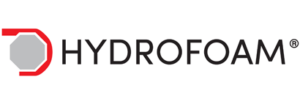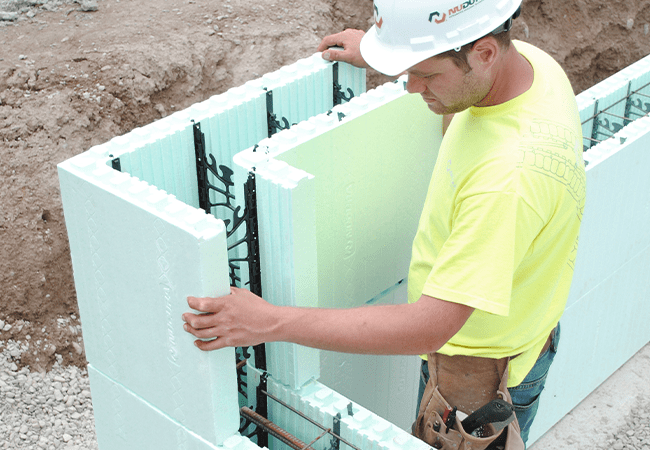Insulated Concrete Form FAQ
FAQ.
How do you attach siding, drywall or other finishes to NUDURA ICF?
The NUDURA form unit has a fastening strip located every 8” (200mm) on centre. These fastening strips are continuous up the full height of the form unit, and have a patented mechanism that interlocks one fastening strip to the one below it or above it. These fastening strips are indicated on the surface of the form by a diamond pattern. They are 1 ½” wide and have a higher pull out strength than a dimensional stud. Different types of cladding will have different installation procedures.
Are there any VOC’s or gaseous emissions from the foam block?
In our NUDURA Insulated Concrete Forms, the insulation is made of EPS and the webs are composed of high-density polypropylene, made from 100% post-consumer recycled plastic. The EPS and the plastic are totally inert and emit no gasses or hydro-soluble substances.
What are the best increments to use for stepped footings?
When using the NUDURA ICF for a foundation wall, and you have stepped footing, the best possible increment to use is 18” (450mm). As the height of the form unit is 18”, you can rip a standard form unit in half for a 9” (225mm) increment. This is also a favorable increment to step footings at.
Will I have to worry about mould growth with NUDURA ICF’s?
EPS foam is an inert material, meaning it is very slow in any reaction, and there are no active properties to it. This does not mean however that mould will never propagate on an ICF wall just because it uses EPS as insulation. The truth is, if you do not have sufficient air flow, you can accumulate an excess of moisture through condensation at your openings. This build up of water, if not evaporated, will eventually cause mould to grow on the paper of the drywall. This is why when dealing with your HVAC system you must adjust it accordingly for a tighter building envelope.
How high can I build with NUDURA?
There is no height limit for NUDURA ICF buildings. We have supplied many projects on a commercial level that have gone up multiple storeys using the NUDURA ICF to form structural walls.
How is NUDURA a ‘Green’ building product?
NUDURA is Green in a number of ways. The material of the webs is 100% recycled. The material for the foam is 100% recyclable. Using NUDURA as opposed to traditional building methods cuts down the amount of wood used, which has become a precious commodity. By reducing waste and shipping space required, NUDURA also impacts the environment in a very positive manner.
How thick can I make my NUDURA walls?
NUDURA Insulated Concrete Forms come in 5 different core sizes. Standard thickness are 4” (100mm), 6” (150mm), 8” (200mm), 10” (250mm) and 12” (300mm). NUDURA also sells the form units in unassembled forms as well for flexibility. With the 4-Way Web Connector, you can now take any of the thicknesses mentioned above and combine them for different combinations of larger sizes. Ask your local distributor about the 4 Way Web Connector and what you can do with it.
Do my designs and plans have to be done specifically for NUDURA?
Your plans do not HAVE to be designed for NUDURA Forms. It helps the construction process go faster if the modular dimensions of the form unit are considered, however NUDURA’s forms are flexible in that you can adapt it to an existing design. Should you want to design using NUDURA’s most optimal dimensions, ask your local distributor for the Dimension Layout Guidelines.
Where is waterproofing necessary?
Although the joints between the NUDURA form units are tight, below grade a waterproofing is still necessary. NUDURA sells a peel and stick waterproofing, that is easy to apply and carries a warranty of two years. This membrane must cover the foundation walls. In situations where you have an attached garage, the below grade wall shared with the basement must be covered, and a 4’ (1200mm) overlap to the adjacent walls.
Do I still require a vapour barrier with NUDURA?
According the standard ASTM E 96, to qualify as a vapour barrier, a material must not exceed 45 ng/Pasm². This unit denotes the ‘permeance’ of the material, meaning how much moisture per force applied (air pressure), in a second over a square area. Our EPS foam has a permeance value of 36 ng/Pasm², therefore the NUDURA Type II EPS qualifies as a vapour barrier.
How do you fasten the baseboard in a NUDURA house?
The best way is to rip a plywood strip 2 to 2 1/2″ wide and screw it in place to the webs along all the walls. Fasten these strips at every fourth web. Now the drywall contractors can set their drywall on top of it, and will cut their top sheets accordingly to suit this height. The result is you have full wood fastening for nails along the complete wall surface and the plywood is guaranteed to be covered by the baseboard.
How do you fasten a typical 1104 type box to the walls?
Our form panel thickness is 2 5/8”. This is deep enough to accommodate almost every standard depth electrical box. Deeper boxes are easily accommodated by simply gluing a square of foam on the inside of the form at the location being planned for the box during the pre-pour phase of the installation process.
How do you attach siding, drywall or other finishes to NUDURA ICF?
The NUDURA form unit has a fastening strip located every 8” (200mm) on centre. These fastening strips are continuous up the full height of the form unit, and have a patented mechanism that interlocks one fastening strip to the one below it or above it. These fastening strips are indicated on the surface of the form by a diamond pattern. They are 1 ½” wide and have a higher pull out strength than a dimensional stud. Different types of cladding will have different installation procedures.
What type of screws do I use to fasten vinyl siding?
A standard #6 x 1 ½” to 1 ¾” coarse thread “bugle” style or “flute” head (1/4” dia. head) zinc coated or otherwise non-corrosive screw will do nicely (NOTE: as inexpensive as they are – drywall screws with the black sulphur coating will eventually corrode). Equally as useful are standard bright (chrome like) finish #6 or # dia. x 1.5” pan head coarse thread self-tapping screws. These have the added bonus of being able to be used for a multitude of anchorage purposes besides siding fastening and do not corrode as easily as drywall screws.
Where should I make my cuts in a form unit to achieve the desired length of wall?
To achieve your desired length of wall, you will have to use standard form units, corner form units, and then remove certain lengths off each of these to get the desired length of wall. The form is designed to make measuring as easy as possible for the installer. Each interlock along the top and bottom of the form is 1”, and the score line on the outside of the form panel denote 2”. By knowing that the webs are 8” apart, you can use these three units on the form to find where you need to make your cut.
Are there any VOC’s or gaseous emissions from the foam block?
In our NUDURA Insulated Concrete Forms, the insulation is made of EPS and the webs are composed of high-density polypropylene, made from 100% post-consumer recycled plastic. The EPS and the plastic are totally inert and emit no gasses or hydro-soluble substances.
Can concrete be poured into NUDURA Insulated Concrete Forms in cold weather?
If the average temperature in a three day period is below 40° F or 4.5° C then this would be considered to be a cold weather pour. Concrete can be heated and the mixture can be altered as well for this scenario. Provisions can be made so that the full compressive strength of the concrete can be achieved in these lower temperatures. If you have further questions please contact your local distributor.
How do you remove snow from the bottom of the form?
The solution to this problem is to cut a hole in the bottom of the wall the diameter of your forced air tube. By connecting a piece of duct to this hole, you can force warm air through the cavity and cause the ice to melt. To achieve this as quick as possible, it is best to cover the top of the wall with an air barrier to hold in the heat.
What are the best increments to use for stepped footings?
When using the NUDURA ICF for a foundation wall, and you have stepped footing, the best possible increment to use is 18” (450mm). As the height of the form unit is 18”, you can rip a standard form unit in half for a 9” (225mm) increment. This is also a favorable increment to step footings at.
What is a lift height?
A lift height is how high you pour your concrete in one pass around the perimeter of your wall. By ACI 318 standard practice, your lift heights should be 4’ (1200mm) per hour.
What is the total height of a pour?
Concrete is typically poured in 10-12’ (3050-3658mm) levels. Therefore according to the last question and answer, a typical pour consists of 2-3 lifts.
How is concrete properly consolidated?
The concrete must be vibrated to properly consolidate. When consolidating concrete after it has been poured, one must do it in a consistent manner, dipping the ‘stinger’ the total height of the ‘lift’. This type of vibrator should be dipped into the concrete every second web.
Will I have to worry about mould growth with NUDURA ICF’s?
EPS foam is an inert material, meaning it is very slow in any reaction, and there are no active properties to it. This does not mean however that mould will never propagate on an ICF wall just because it uses EPS as insulation. The truth is, if you do not have sufficient air flow, you can accumulate an excess of moisture through condensation at your openings. This build up of water, if not evaporated, will eventually cause mould to grow on the paper of the drywall. This is why when dealing with your HVAC system you must adjust it accordingly for a tighter building envelope.
How high can I build with NUDURA?
There is no height limit for NUDURA ICF buildings. We have supplied many projects on a commercial level that have gone up multiple storeys using the NUDURA ICF to form structural walls.
How is NUDURA a ‘Green’ building product?
NUDURA is Green in a number of ways. The material of the webs is 100% recycled. The material for the foam is 100% recyclable. Using NUDURA as opposed to traditional building methods cuts down the amount of wood used, which has become a precious commodity. By reducing waste and shipping space required, NUDURA also impacts the environment in a very positive manner.
How thick can I make my NUDURA walls?
NUDURA Insulated Concrete Forms come in 5 different core sizes. Standard thickness are 4” (100mm), 6” (150mm), 8” (200mm), 10” (250mm) and 12” (300mm). NUDURA also sells the form units in unassembled forms as well for flexibility. With the 4-Way Web Connector, you can now take any of the thicknesses mentioned above and combine them for different combinations of larger sizes. Ask your local distributor about the 4 Way Web Connector and what you can do with it.
Do my designs and plans have to be done specifically for NUDURA?
Your plans do not HAVE to be designed for NUDURA Forms. It helps the construction process go faster if the modular dimensions of the form unit are considered, however NUDURA’s forms are flexible in that you can adapt it to an existing design. Should you want to design using NUDURA’s most optimal dimensions, ask your local distributor for the Dimension Layout Guidelines.
Where is waterproofing necessary?
Although the joints between the NUDURA form units are tight, below grade a waterproofing is still necessary. NUDURA sells a peel and stick waterproofing, that is easy to apply and carries a warranty of two years. This membrane must cover the foundation walls. In situations where you have an attached garage, the below grade wall shared with the basement must be covered, and a 4’ (1200mm) overlap to the adjacent walls.
Do I still require a vapour barrier with NUDURA?
According the standard ASTM E 96, to qualify as a vapour barrier, a material must not exceed 45 ng/Pasm². This unit denotes the ‘permeance’ of the material, meaning how much moisture per force applied (air pressure), in a second over a square area. Our EPS foam has a permeance value of 36 ng/Pasm², therefore the NUDURA Type II EPS qualifies as a vapour barrier.
Can I hang heavy cabinets or televisions on a NUDURA ICF wall?
Absolutely. Please check our resources section for examples of best practices.
Will I have to worry about mould growth with NUDURA ICF’s?
EPS foam is an inert material, meaning it is very slow in any reaction, and there are no active properties to it. This does not mean however that mould will never propagate on an ICF wall just because it uses EPS as insulation. The truth is, if you do not have sufficient air flow, you can accumulate an excess of moisture through condensation at your openings. This build up of water, if not evaporated, will eventually cause mould to grow on the paper of the drywall. This is why when dealing with your HVAC system you must adjust it accordingly for a tighter building envelope.
How high can I build with NUDURA?
There is no height limit for NUDURA ICF buildings. We have supplied many projects on a commercial level that have gone up multiple storeys using the NUDURA ICF to form structural walls.
How is NUDURA a ‘Green’ building product?
NUDURA is Green in a number of ways. The material of the webs is 100% recycled. The material for the foam is 100% recyclable. Using NUDURA as opposed to traditional building methods cuts down the amount of wood used, which has become a precious commodity. By reducing waste and shipping space required, NUDURA also impacts the environment in a very positive manner.
Can I hang heavy cabinets or televisions on a NUDURA ICF wall?
Absolutely. Please check our resources section for examples of best practices.
Our products
Request a quote for your upcoming project.








